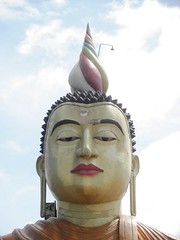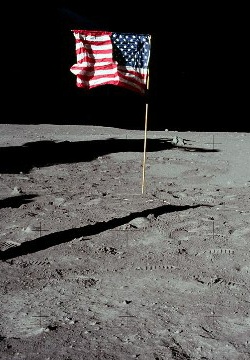After three days roaming a shadeless desert without sunscreen, the only burn I have is a friction burn on my thighs from the ceaseless agitation of my loins against camel back, leaving my skin in those regions feeling like I slid down a rope too fast in gym class. I swear upon the names of the ~1,000,000 Hindu gods that I will never ride a camel again until they devise a way to mount a cushioned gyroscope to the saddle.
Around the time we approached the outskirts of Jaisalmer at breakneck speed, passing the common sights of an urban periphery such as high-voltage power lines, military police checkpoints, and random piles of cinderblocks our driver loaded a ghastly-looking, heavily-scratched Indian pop CD depicting on its face two Rajasthani puppets dancing while a silhouetted caravan of camels crossed in the background. As this digital monstrosity began to play, I thought about how far civilization and technology have come from the days of wandering in the desert to produce such a device, and as the disembodied puppet voice wailed cacophonously over the same abominable Indian drum machine used in every Hindi pop song since 1973, I looked out the window, saw a pair of fat tourists taking digital photographs of a pig sifting for banana peels in a pile of spare rickshaw motor parts, and concluded that Progress is a lie.
Jaisalmer, a teeming metropolis of noise and commerce to the villagers who flock here for work and trade, is in fact a charming and fairly relaxing Indian city. Excuse me, an Indian squirrel just stole the last bite of my honey sandwich. Guess whose species is going on the nemeses list.
Anyways, Jaisalmer is a quaint medieval desert town of 65,000 people pretty much in the middle of nowhere that depends largely on its convenient location for an Indian Air Force base from which to carpet-bomb Pakistani soldiers guarding their half of the sand. Rising from the center of the old city is Jaisalmer's fort, also known as the Golden City because it is constructed entirely of yellow sandstone. It is actually closer in color and texture to the cheese filling in a Ritz Bitz cracker, and looks like it has been crumbling because people have been justifiably scraping bits off to go with their popcorn. In fact the fort is crumbling primarily because of poor conservation but also because the Maharawals of Jaisalmer, being Rajput kings, spent centuries getting in wars which Jaisalmer tended to lose. It's no surprise that they lost. Their kingdom consisted of some 100 tiny villages in what even they admit is a "sandy waste" and a capital city that had a population of 7,000...in the year 1900. During their epic defeats of the middle ages in which the soldiers of the fort ended up resorting to mass suicide their army probably consisted on 17 dudes sharing a camel and a bunch of scarecrows. In the palace armory, along with the usual assortment of swords, shields, daggers, and ungainly firearms, is an example of a warrior's bow and arrow...from the early 20th century. Dynastic war fail.
In any case, despite Jaisalmer's historical ineptitude it is very beautiful. As it is located in a part of the country boasting neither "inhabitants" nor "resources", it is spared most of the unpleasant effects of modernity that plague other Indian cities. The fort stands out on the hilltop against the pristine, cloudless sky like the gods' own sandcastle, and from below you can just make out traces of the bustling life within. The fort is not just a monument but part of the city, with thousands of people living within its old servant homes. A short climb up through the many winding gates leads into the heart of the city, where the Maharawal's palace hangs overhead, looking over a tight maze of narrow streets, crumbling mansions, and ancient homes and temples. Homes and shops are built into the sandstone bastions, with restaurant kitchens sometimes built around 14th-century cannons sticking out the window and fabric shops with holes in the roof from long-ago sieges.
At one corner of the fort is a claustrophobic labyrinth of seven Jain temples. I knew this was going to be good. When I got there I discovered that somewhere along the way, due to crowded conditions within the fort, the Hindus and Jains decided to share the temples. The result, which combines the Jain penchant for obsessively ornate carving on every available surface with the Hindu penchant for images of wacky deities, is astounding. Connected to each other by barely-noticeable passages and twisting staircases, each of the temples contains a dazzling array of carved art, where hundreds of marble and gold statues of calmly seated Jain tirthankaras rest in shrines adorned in intricate scenes of Hindu gods with varying numbers of body parts belonging to different species playing music, dancing, carrying animals, and having sex. In the midst of all this, as Jain priests make offerings of holy paste in their inner sanctums, Hindu priests only feet away offer incense to their gods and circle about counting hanging bats on the sculptures as a measure of good fortune. Revealing an unusual familiarity with Jain and Hindu mythology (for a tourist), I was invited deeper into this shadowy warren of the gods where foreigners are rarely led and had the meanings of each of the multitude of statues explained to me in excessive and mind-boggling detail. I left baffled but satisfied.
Back out on the streets I reveled in the atmosphere of Jaisalmer. Not only can you happily breathe the actual atmosphere, but the ambiance is quintessentially Indian, almost a parody of itself. A platoon of poorly-mustached soldiers, half named Singh, attempted to maneuver a broken-down army truck while groups of splendidly-mustached old desert men in pink and orange turbans sat around drinking chai, only to briefly restore the engine and have it fail again when they were forced to stop by a barricade of contentedly digesting cows sitting in the shade beneath the last fort gate. Walking down the street, the merchants tried with all their energies to entice me to their shops. A wild-eyed dealer of arts and antiques gesticulated feverishly and implored "FEAST YOUR EYES, YES, FEAST YOUR EYES ON THIS CAVE OF WONDERS, THE FINEST ANTIQUES IN ALL THE INDIA, FOR YOUR VERY SELF THIS DAY." A massive-grinned man with a metal pot balanced on his head followed me through the alleys playing a Rajasthani violin and enthusiastically saying "yes, very nice" at random intervals before unleashing a hyperactive and unmelodious burst of sound from his instrument and then suddenly shifting back into song.
I climbed into one of the bastions to eat at a restaurant that offered Tibeto-Mexican fusion cuisine. It was not good.
Finally, after a visit to the Maharawal's equally sand-colored palace I descended to the lower old city and sat on a rooftop, dreaming wistfully of the desert and gazing into the sky...
How many hump-backed livestock change?
Why are camels so deranged?
Where were you when we were getting high?
Clumsily walking through the sand
Moving slower than Gondwanaland
Where were you when we were getting high?
Someday you will find me
Caught beneath a sand dune
In a camel-spit supernova in the sky
Someday you will find me
Caught beneath a sand dune
In a camel-spit supernova
A camel-spit supernova in the sky
Nov 17, 2009
Subscribe to:
Post Comments (Atom)









No comments:
Post a Comment
Commenting Rules:
1)No spam, viruses, porn etc.
2)DO NOT POST GF-B's REAL NAME
3)Remember this is a public website, don't provide sensitive info about yourself in the internet!